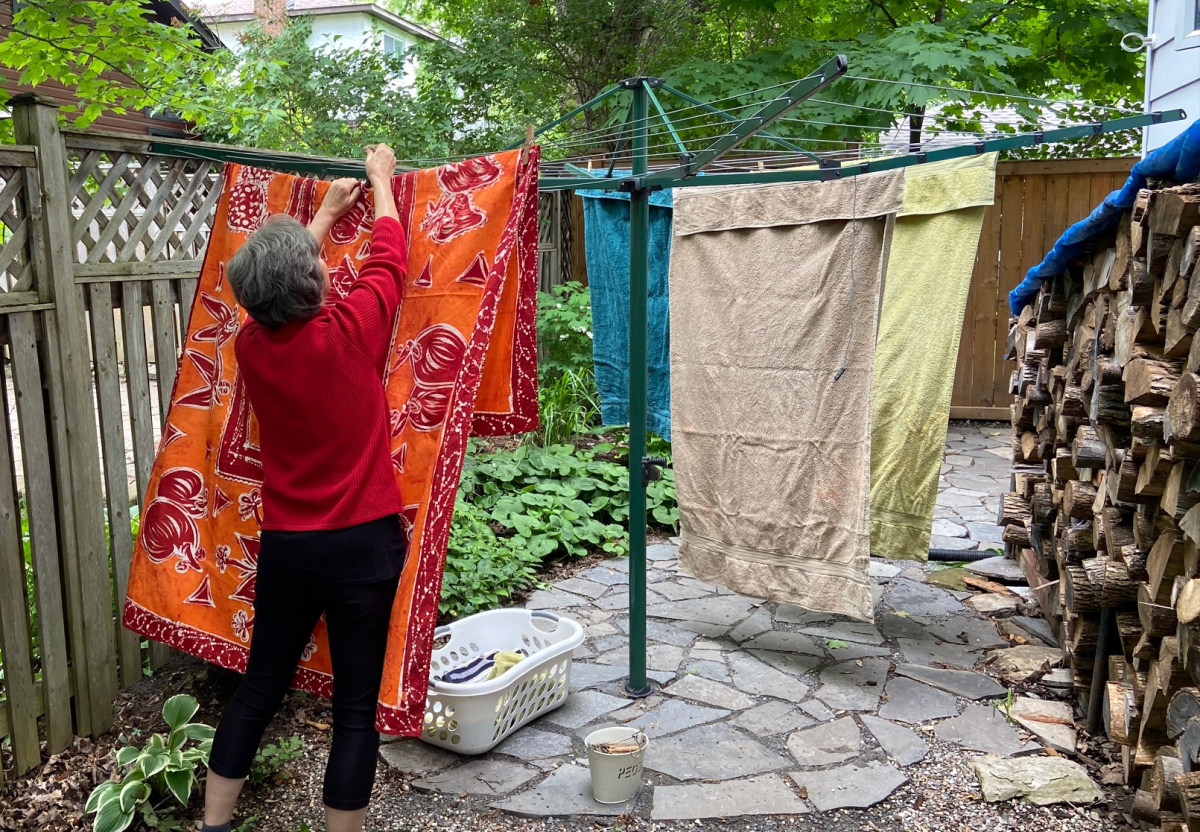Support strong Canadian climate journalism for 2025
Lenore Fahrig has been dryer-free for over 30 years, “including when our son was small and we had cats and a dog. We even did cloth diapers dryer-free.”
“I guess we’re just kind of cheap,” she laughs. “It costs a lot of money to dry clothes. The air does it for free if you hang them up.”
Citing Natural Resources Canada, Pollution Probe’s Richard Carlson says an average household uses about 900 kilowatt hours of energy annually to dry clothes. “If you are drying during peak hours, that’s about $153,” Carlson says. “During off-peak hours, that’s about $75.”
These numbers apply to Ontario and vary province to province. But compared to other appliances, dryers have not seen any major efficiency improvements in the past couple of decades. “Washers, electric ranges, fridges, dishwashers have all made impressive energy efficiency gains,” he notes. “Dryers have not.”
Dryers are also hard on your clothes — where do you think all that lint comes from? “Any of my good clothes, I would never put in the dryer,” Carlson says. “The longer your clothes last, the more environmentally friendly it is.”
If using a dryer is a necessity, here are his tips for reducing their environmental impact:
- Use the dryer in off-peak hours when there isn’t a large demand for power. “When people get home at [six] and start making dinner, the demand for power goes up sharply,” he says. “That’s generally when the most polluting generating occurs. If you use it during off-peak hours, the electricity is more likely to be supplied by low-emitting sources.”
- Make sure the vent is clear and clean the lint trap after every load. “This saves you money because it will require less electricity to run the dryer. Anything you can do to make an appliance run more efficiently will be more environmentally friendly.”
- On good weather days, hang your clothes outside. On bad weather days, put them on hangers, on radiators, on the backs of chairs.
The David Suzuki Foundation also recommends using wool dryer balls to reduce drying time.
“Part of not using a dryer is also owning enough underwear,” Fahrig advises. She further recommends giving things “a good shake” before hanging for fewer wrinkles.
Here are some other suggestions:
- Get an outdoor clothesline. An umbrella clothesline requires little space and easily handles at least a couple loads of laundry.
- Get some portable drying racks.
- Use trouser hangers — the kind with clips — to hang skirts, pants, jeans and boxer shorts.
- Use regular hangers for T-shirts, blouses, shirts, etc. The shower curtain rod in the bathroom is a great place to hang them. Most stuff dries overnight.
Like Fahrig, I have been without a dryer since mine conked out in 1998. I have discovered the world is divided between people who love or hate “crunchy towels”. Air-dried towels will be crisper, but Fahrig says she prefers them that way. “I feel they dry you better when they’re a bit crispy.”
One Small Thing You Can Do Right Now is a monthly column on everyday actions we can all take to help save the planet.
Please share your ideas on being more environmentally responsible in the comments section below.
Becky Rynor is a journalist based in Ottawa.






Comments
Thanks for sharing this good practice, Becky. I've been doing this since 1979 when we bought our first house. Money was tight. Remember 12 to 20 per cent mortgage interest rates? I never stopped avoiding the dryer for all the reasons you have given. It also adds much needed moisture to the air in the winter.
We gave up the dryer 5 years ago. I love the smell of clothes that have been dried outside.
This year, our goal for 2022 is to reduce our energy usage. So far, we’ve reduced our monthly hydro usage by 75%. One thing we do is put excess hot water from boiling the kettle into a thermos, so we don’t re-boil water when making hot drinks throughout the day. It’s amazing how making small changes like this adds up to significant savings.
Fine if you have a back yard.
With small clothes racks and the shower area (and the basement if you have one) there is lots of room to dry inside. Including during the winter!
Unfortunately many apartment and condo complexes don't allow drying laundry on balconies or patios. I'm trying to get the province to override those silly strata bylaws, as they've done in Nova Scotia with their Clothesline Act.
With small clothes racks and the shower area (and the basement if you have one) there is lots of room to dry inside. Including during the winter!
Please consider contacting your MLA if you want to get the Province to override strata bylaws that prohibit laundry drying outside.
A greater concern is elimination of carbon based electricity production. Where I live, which is near Niagra falls, carbon isn't a big issue. I am concerned that Ford's big victory will garantee expansion of the natural gas plants, The latter is a big concern, I am not too concerned about the $75. Keep in mind the stats given don't seem to account for the fact winter isn't a good outdoor drying time.
With small clothes racks and the shower area (and the basement if you have one) there is lots of room to dry inside. Including during the winter!